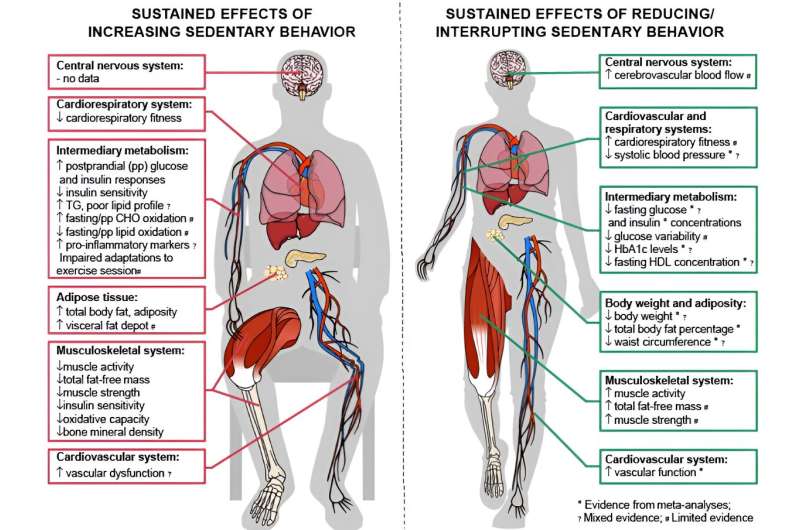
Credit: Physiological reviews (2023). DOI: 10.1152/physrev.00022.2022
The more comprehensive review of the effects of sedentary behavior on health and risk of death has intensified calls for reducing the time spent sedentary and increasing physical activity.
The extensive review, titled “Physiology of Sedentary Behavior,” was published this month in Physiological reviewsexamines current understanding of sedentary behavior (SB).
It is determined that the physiological evidence now available should be used to refine public health and clinical practice guidelines to extend beyond the widely prescribed simple message of exercise more and to move towards a more comprehensive message of “sit less, move more and exercise.”
The head of the Baker Heart and Diabetes Physical Activity Laboratory and the Baker-Deakin Department of Lifestyle and Diabetes, Professor David Dunstan, is working with GPs and primary care providers to push for inclusion of the application “How much time do you spend sitting?” in any conversation about exercise, as the benefits of exercise also depend on how much time you spend sitting.
“Many of us think that if we take a short walk, run or gym session after a day spent sitting at a desk, we’re doing everything necessary for good health, but that’s not the case,” said Prof. Dunstan. “That’s because the benefits of these physical activities depend on how much time you spend sitting.
“If, for example, you sat at your desk for hours but then went out for a jog after work, yes, you would definitely get some health benefits from that jog, but the nine hours of sitting during the day drags those health benefits down.” below.
“By breaking up the time you spend sitting during the day, you stop the buildup of your sedentary time, which basically restarts the body’s engine (our muscles) and reduces your risk.”
There is a long list of recognized health risks associated with sedentary behavior, including high blood pressure, increased body fat, poor vascular function, and increased blood sugar and insulin.
Professor Dunstan hopes this review will help incorporate his evidence-based risk identification matrix into healthcare practice, which shows how physical activity and sedentary behaviors are inextricably linked to health risk.
“In the same way that the benefits of physical activity depend on how much time a person spends sitting, the health risks of excessive sitting also depend on how much physical activity a person engages in,” said Prof. Dunstan.
“That is why the question of how long you sit should be asked alongside how much physical activity you are engaging in, and that if you are physically inactive and sit for long periods, you may initially start with a reduction in sitting time as a pathway to being more active.
“We need to sit less, move more and exercise to reduce our health risk.”
More information:
Ana J. Pinto et al, Physiology of sedentary behavior, Physiological reviews (2023). DOI: 10.1152/physrev.00022.2022
Provided by the Baker Heart & Diabetes Institute
Citation: Study shows benefits of exercise based on hours spent sitting (Aug 30, 2023) retrieved Aug 31, 2023 from https://medicalxpress.com/news/2023-08-benefits-hours-spent.html
This document is subject to copyright. Except in any fair dealing for the purpose of private study or research, no part may be reproduced without written permission. The content is provided for informational purposes only.
#Study #shows #benefits #exercise #based #hours #spent #sitting
Image Source : medicalxpress.com